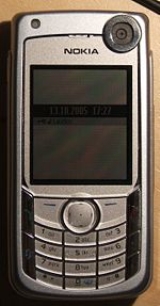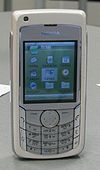
Nokia 6680
Encyclopedia
The Nokia
6680 is a 3G handset by Nokia, running Symbian
operating system, with Series 60 version 2 user interface. The device features Bluetooth
, a 1.3 megapixel fixed focus camera, front VGA (0.3 megapixel) video call camera, hot swappable Dual Voltage Reduced Size MMC (DV-RS-MMC) memory expansion card support, stereo audio playback and a 2.1", 176x208, 18-bit (262,144) color display with automatic brightness control based on the environment.
Announced in February 2005, they reached the market in May 2005.
The 6680 remains a high-end 3G
device. It is a smartphone offering office and personal management facilities, including Microsoft Office
compatible software. The phone initially offered an innovative active standby mode, but this was removed by some network operators (for example, Orange) under their own adapted firmware. The phone, however has been marred by a more-than-normal number of bugs, which have included crashes and security issues. The phone was also criticised in some reviews for the relatively limited memory available.
In addition to the standard RS-MMC card, the 6680 can also use Dual Voltage Reduced Size MMC (DV-RS-MMC) cards which are also marketed as MMCmobile. While these cards have the same form factor as RS-MMC, the DV-RS-MMC have a 2nd row of connectors on the bottom. Make sure any upgraded card supports or claims to support 1.8V in addition to 3.0V.
The phone operates on GSM 900/1800/1900, and UMTS 2100 on 3G networks.
During its development, the 6680 was nicknamed Milla.
This handset was similar to its predecessor, the Nokia 6630. Key changes were the new "active standby" feature, the facility for face-to-face video calls, a camera flash, better screen and improved styling.
This handset was the spring-board onto the N-Series
, its successor being the N70
.
The hardware application platform of this device is OMAP
1710.
 The Nokia 6681 and Nokia 6682 are GSM handsets by Nokia
The Nokia 6681 and Nokia 6682 are GSM handsets by Nokia
, running the Series 60 user interface on the Symbian
operating system. The phones are GSM-only versions of the Nokia 6680.
The only difference between the 6681 and the 6682 is the fact that the 6681 is targeted at the European market, being a GSM 900/1800/1900 tri-band handset, while the 6682 is targeted at the American one, supporting 850/1800/1900 frequencies.
In turn, both handset's specs are almost identical to those of the 6680, except for the lack of support for 3G networks, which means no UMTS support, or video call, thus the absence of the front video call camera.
The hardware application platform of the device is Omap
1710. The resolution of the display is 176x208.
Nokia
Nokia Corporation is a Finnish multinational communications corporation that is headquartered in Keilaniemi, Espoo, a city neighbouring Finland's capital Helsinki...
6680 is a 3G handset by Nokia, running Symbian
Symbian
Symbian is a mobile operating system and computing platform designed for smartphones and currently maintained by Accenture. The Symbian platform is the successor to Symbian OS and Nokia Series 60; unlike Symbian OS, which needed an additional user interface system, Symbian includes a user...
operating system, with Series 60 version 2 user interface. The device features Bluetooth
Bluetooth
Bluetooth is a proprietary open wireless technology standard for exchanging data over short distances from fixed and mobile devices, creating personal area networks with high levels of security...
, a 1.3 megapixel fixed focus camera, front VGA (0.3 megapixel) video call camera, hot swappable Dual Voltage Reduced Size MMC (DV-RS-MMC) memory expansion card support, stereo audio playback and a 2.1", 176x208, 18-bit (262,144) color display with automatic brightness control based on the environment.
Announced in February 2005, they reached the market in May 2005.
The 6680 remains a high-end 3G
3G
3G or 3rd generation mobile telecommunications is a generation of standards for mobile phones and mobile telecommunication services fulfilling the International Mobile Telecommunications-2000 specifications by the International Telecommunication Union...
device. It is a smartphone offering office and personal management facilities, including Microsoft Office
Microsoft Office
Microsoft Office is a non-free commercial office suite of inter-related desktop applications, servers and services for the Microsoft Windows and Mac OS X operating systems, introduced by Microsoft in August 1, 1989. Initially a marketing term for a bundled set of applications, the first version of...
compatible software. The phone initially offered an innovative active standby mode, but this was removed by some network operators (for example, Orange) under their own adapted firmware. The phone, however has been marred by a more-than-normal number of bugs, which have included crashes and security issues. The phone was also criticised in some reviews for the relatively limited memory available.
In addition to the standard RS-MMC card, the 6680 can also use Dual Voltage Reduced Size MMC (DV-RS-MMC) cards which are also marketed as MMCmobile. While these cards have the same form factor as RS-MMC, the DV-RS-MMC have a 2nd row of connectors on the bottom. Make sure any upgraded card supports or claims to support 1.8V in addition to 3.0V.
The phone operates on GSM 900/1800/1900, and UMTS 2100 on 3G networks.
During its development, the 6680 was nicknamed Milla.
This handset was similar to its predecessor, the Nokia 6630. Key changes were the new "active standby" feature, the facility for face-to-face video calls, a camera flash, better screen and improved styling.
This handset was the spring-board onto the N-Series
Nokia Nseries
Nokia Nseries is a multimedia smartphone product family which is engineered and marketed by the Nokia Corporation.The Nseries devices are known to commonly support multiple high-speed wireless technologies, such as 3G, or Wireless LAN....
, its successor being the N70
Nokia N70
The Nokia N70 is a multimedia 3G smartphone made by Nokia and launched in Q3 2005. This phone is one of the first phones released for Nokia's line of Multimedia computers, the Nokia Nseries. Nokia N70 is released alongside with Nokia N90 and Nokia N91....
.
The hardware application platform of this device is OMAP
OMAP
OMAP developed by Texas Instruments is a category of proprietary system on chips for portable and mobile multimedia applications. OMAP devices generally include a general-purpose ARM architecture processor core plus one or more specialized co-processors...
1710.
Variants

Nokia
Nokia Corporation is a Finnish multinational communications corporation that is headquartered in Keilaniemi, Espoo, a city neighbouring Finland's capital Helsinki...
, running the Series 60 user interface on the Symbian
Symbian
Symbian is a mobile operating system and computing platform designed for smartphones and currently maintained by Accenture. The Symbian platform is the successor to Symbian OS and Nokia Series 60; unlike Symbian OS, which needed an additional user interface system, Symbian includes a user...
operating system. The phones are GSM-only versions of the Nokia 6680.
The only difference between the 6681 and the 6682 is the fact that the 6681 is targeted at the European market, being a GSM 900/1800/1900 tri-band handset, while the 6682 is targeted at the American one, supporting 850/1800/1900 frequencies.
In turn, both handset's specs are almost identical to those of the 6680, except for the lack of support for 3G networks, which means no UMTS support, or video call, thus the absence of the front video call camera.
The hardware application platform of the device is Omap
OMAP
OMAP developed by Texas Instruments is a category of proprietary system on chips for portable and mobile multimedia applications. OMAP devices generally include a general-purpose ARM architecture processor core plus one or more specialized co-processors...
1710. The resolution of the display is 176x208.
Product pages
- Nokia 6680 Official product page
- Nokia 6681
- Nokia 6682
- Rui Carmo's 6680 first impressions
- OCW's 6680 review
- 6680 review and specifications roundup
- Texas Instruments OMAP 1710
- Texas Instruments OMAP 1710

